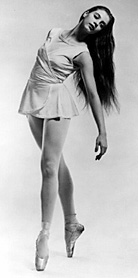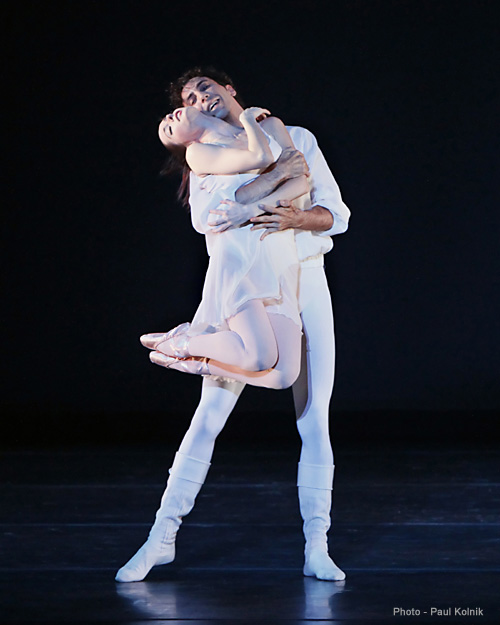|
I have been waiting for this moment. The first time the Suzanne Farrell Ballet came to the West Coast I happened to be in Europe, to my great regret. Rumor had it that here, in this young company, the spirit of Balanchine's choreography was still alive, or rather, alive again after having died a long and agonizing death all over the world and, most poignantly, at its original home, the New York City Ballet. If you had eyes to see and a memory to rely on there was no doubt about it. The loss of style and technique was as rapid as Balanchine himself had predicted. But then his very best dancer and muse, Suzanne Farrell, who had stopped dancing in 1989, decided to step in and put her outstanding dancer's experience, memory and loyalty to service, all by herself. (Her gifts as a teacher and Balanchine connoisseur par excellence were not favored by Peter Martin, by then the less gifted next director of NYCB.) When she was fired from NYBC, in 1993, she taught a master class, "Exploring Ballet with Suzanne Farrell" at the Kennedy Center in D.C., which turned into a yearly summer event for dancers nation-wide. In 1995, she became a répétiteur for the Balanchine Trust and started arranging and staging Balanchine ballets all over the world. She arranged a highly regarded week-long Balanchine season at the Kennedy Center in 1995. Five years later she founded her own company and began training her dancers in the art of the late master in order to carry forth his legacy. She and her company quickly became an internationally renowned authority of that legacy. Two years ago, when Farrell created the "Balanchine Preservation Initiative" to present "lost" or rarely seen Balanchine works, the New York Times called it "one of the most courageous projects in ballet today". 9 of the lost and found ballets are now in the repertoire of Farrell's company among its altogether 35 ballets, most by Balanchine plus a few works by Jerome Robbins and Maurice Béjart.
Farrell, in her prime as a dancer, was the realization of all you could hope for in ballet, all you could dream of as a spectator.  One can only wonder what it must have been like for a choreographer in his prime to find this dancer. Nobody, none of the ballerinas Balanchine was obsessed with and married, was anything like this new child-woman (42 years younger than he). Nobody rivaled the grace, the natural innocence and joy of dancing, the reckless speed and sure-fire attack combined with expressive lyricism, the high-risk abandon and trust in spontaneity, the fluidity of arms and gestures, the capacity to convey meaning with every step, and, last but not least, the physical beauty, the ideal, neo- classical proportions of the body Balanchine and ballet needed, with the doe-eyed, un-self-conscious face – each one of these qualities enough to stop your heart. One can only wonder what it must have been like for a choreographer in his prime to find this dancer. Nobody, none of the ballerinas Balanchine was obsessed with and married, was anything like this new child-woman (42 years younger than he). Nobody rivaled the grace, the natural innocence and joy of dancing, the reckless speed and sure-fire attack combined with expressive lyricism, the high-risk abandon and trust in spontaneity, the fluidity of arms and gestures, the capacity to convey meaning with every step, and, last but not least, the physical beauty, the ideal, neo- classical proportions of the body Balanchine and ballet needed, with the doe-eyed, un-self-conscious face – each one of these qualities enough to stop your heart.
Will Suzanne Farrell ever have the luck to find a dancer who would be her young double and, under her guidance, realize once again what Balanchine envisioned and coaxed out of her? I doubt it. And even if she would find such a dancer, would there be the passion, the perhaps necessary amorous, erotic, sexual obsession that led Balanchine and his muse to Parnassus? Farrell would have to do what Balanchine did: create her own school and groom and train the dancers who are ideally needed for the task. When you watch old tapes of Balanchine's work from a time when he only had what Farrell has now: a drop-in company and very short rehearsing times, the difference in style and class is obvious.
So far, with my severely limited judgment, I can say that the company seems touchingly young, excitingly competent and eager, but a bit shy of personality. The program I saw had two well-known Balanchine pieces -- the Pas d'action from Mozart's "Divertimento No. 15", Stravinsky's "Agon," as well as a fun little Blues pas de deux from the "lost and found" ballet "Clarinade" which he had tossed off for Farrell in 1964 to Morton Gould's clarinet. Usually, at the New York City Ballet or most any established ballet company, such an evening would have been a long, somewhat interesting and somewhat laborious, rather cold affair. Here, the time went by like a whiff of warm air. Everything was danced with such freshness, precision, and lively geometry that it was possible, once again, to remember the thrill of the past. "Agon" (1957) always had the stamp of a masterpiece, but here the stark, edgy piece felt as if it could have been an avant-garde piece of today. Danced this well, Balanchine's masterpieces radiate a modernism and daring originality that only very few choreographers of our time — like Bill Forsythe in his Balanchine-inspired "Artifact Suite" (Scene4, April 2007) — could match.
 |
There was something uplifting in the all-out engagement of these young dancers. The women ("Ballet is woman," as Balanchine famously pronounced) appeared to be eager servants to the higher cause, even to a fault. I kept wondering if they were hiding ego, ambition, or personality from fear of not being absolutely loyal to the vision of Master and Muse. Perhaps it is simply an overwhelming task to step into the shoes of the legendary Farrell, especially when you can study the legend on film and go crazy trying to imitate what she does. Of course, that's the last thing Farrell would encourage her dancers to do. She wants them to be "themselves," but such a proposition has its natural limits.
From the back of the group, however, in the Divertimento that opened the program, one dancer stood out. I have often noticed a strange phenomenon onstage: charismatic personalities, those with star potential, seem to catch the light, or rather, meet the light in a way that makes them instantly the center of attention, no matter if they are placed at the back of a group. (Sometimes it even happens in the absence of any light: Balanchine's principal dancer Jacques d'Amboise discovered the 16-year-old Farrell one day in 1961, when he noticed her at the very end of the line of swans in Swan Lake – invisible to the audience, dancing as if it were the last dance of her lifetime.) This one, Sara Ivan, had a faint resemblance with the young Suzanne Farrell, a special physical beauty, a very natural-seeming grace, a lack of "attitude" or "ballerina posing" (which, by the way, was absent from the entire company). She caught the attention because she brought more than fresh precision and loyalty to the dance – she made, as Balanchine used to put it, "the beautiful more beautiful."
I was surprised to learn from the program that she has joined 4 years ago and is only in the Corps de ballet. (In spite of its small size, the company is organized in the strict hierarchy of the New York City Ballet, the Paris Opera Ballet, or any other traditional company.) Before attending "Exploring Ballet With Susanne Farrell" Sara Ivan has danced with the Washington Ballet -- that's all we were told. But she outdanced everyone else and, interestingly, got featured next, in the "scène d'amour" from Romeo and Juliet. This piece, set to music by Berlioz, was added as a small homage to Farrell's "second Mr. B", Maurice Béjart, who had given her a home when Balanchine, unable to deal with Suzanne's refusal to become "just another Balanchine wife," retaliated against the young man she had married -- dancer Paul Mejia. When no other ballet company in the States extended an invitation to the jobless couple, clever fox Béjart saw his moment. He clearly had nothing to fear from big Mr. B in New York.
From 1969 to 1975, Farrell became the brightest female star at the controversial "Ballet of the 20th Century"– until Balanchine finally caved in and took his sourly missed dancer back. Béjart choreographed his Romeo and Juliet for her (you can see excerpts from it on the Oscar-nominated documentary "Suzanne Farrell: Elusive Muse" on DVD) and young Sara Ivan (with partner Momchil Mladenov) rendered some of the kitschy and vulgar Béjart moves almost irrelevant and almost made me forget with her Juliet that I was not seeing "the real thing."
I have to stress the "almost". The minute I was back home I watched Farrell's "Elusive Muse" again on DVD and was once again, or perhaps more than ever, speechless.
Cover Photo - Mike Kepka
Photos Courtesy of Cal Performances
|
|

